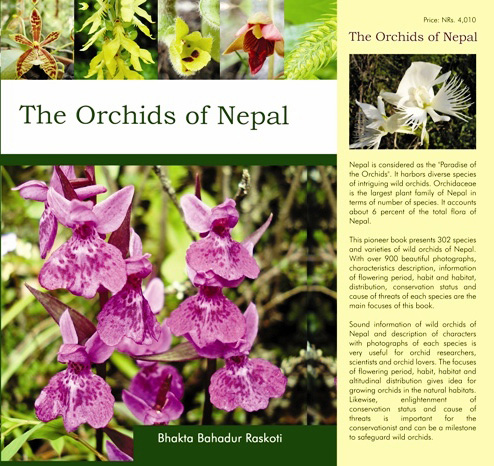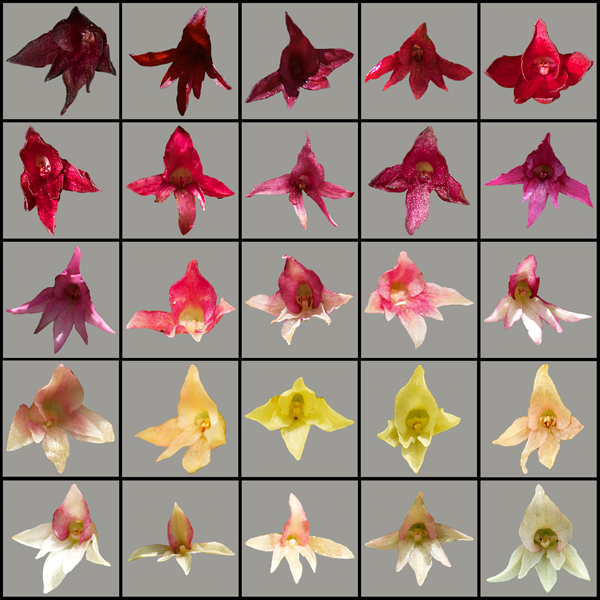
In July, the dark red heads of Nigritella rhellicani (syn: Nigritella nigra ssp. rhellicani) are covering many alpine meadows. In some rare places, the flowers show remarkable colour variatation. After studying the Nigritella hues of the Dolomite Alps, this year I visited the Swiss canton Valais: Near Chandolin there is a place in an altitude of about 2400 m with pink and yellow flowering Nigritella rhellicani. The tableau above shows the colour varieties in both the Dolomites and Switzerland. The yellow flowering forms grow near Chandolin – they obviously miss the anthocyanins, but have other pigments as probably carotenoids. The reasons for this special forms are unknown up to now.
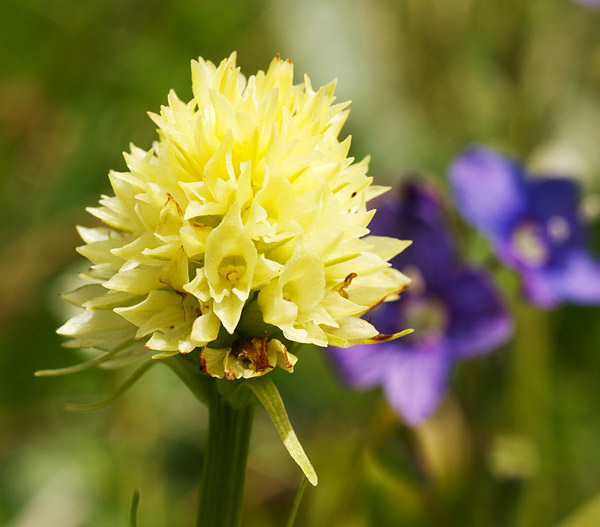
Albiflora studies on the Crimean Peninsula
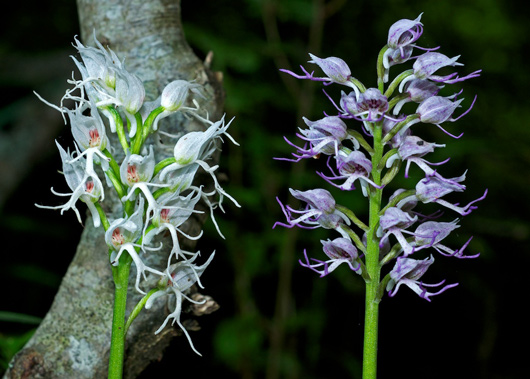
Exploring the Crimean Pensinsula for orchids, species like Comperia comperiana, Steveniella satyrioides or Orchis punctulata are especially noteworthy. Albiflora forms, though, are quite rare in this Ukrainian region. Vladimir Isikov of the Nikita Botanical Garden told me that he has seen only three species with white-flowered forms: Orchis simia, Neotinea tridentata and Anacamptis morio ssp. caucasica (which he referred to as Orchis picta). Obviously there are no orchid species on the Crimean Peninsula heading to a direction which favours white flowering.
But near тылобое (Tylovoye) we found an edge of a forest with a group of 26 Orchis simia under a pine and 5 albiflora plants among them. In this small population there was obviously some kind of reproduction of the white-flowered plants.
Neotinea tridentata has a marked variability, as it is also noted by H. Kretzschar, W. Eccarius and H. Dietrich in their book „Die Orchideengattungen Anacamptis, Orchis, Neotinea“ (Buergel 2007, p. 206/207). On the Crimean Peninsula the dominant colour of flowers is light purple. I’ve found 3 white flowered plants, which led me to a rough estimate of 2 albiflora plants per 1000 Neotinea tridentata.
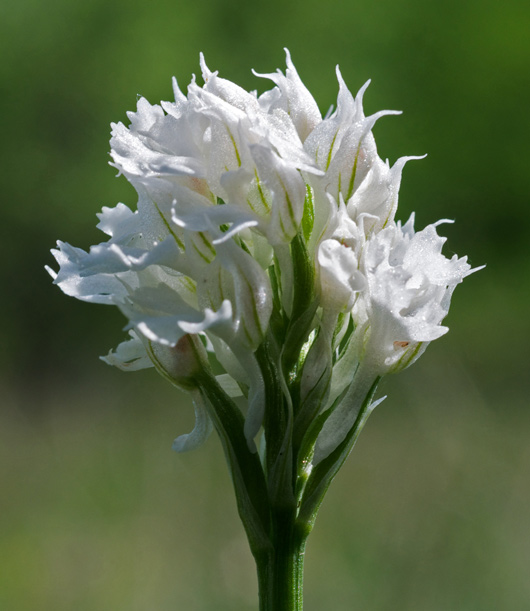
Among the Anacamptis morio, Orchis mascula, Orchis purpurea or Anacamptis pyramidalis seen on our 10-day-trip there have been no white-flowered plants. But in a forest near гончарное (Goncharnoye) there was an albino form of Epipactis helleborine.
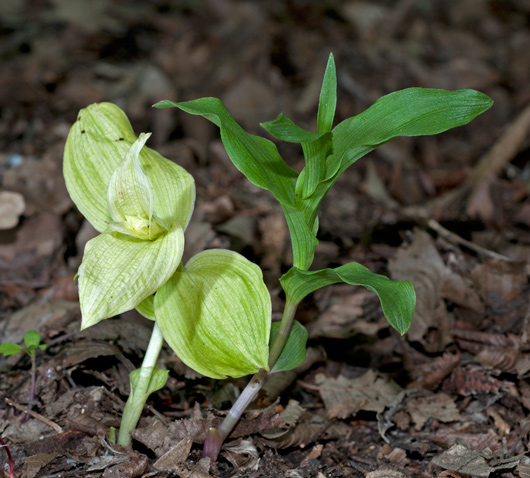
Beyond the orchid flora I noticed white flowers of Polygala major, the endemic Onosma taurica and Papaver spec. Interesting was also a Polygonatum odoratum with half white leaves.
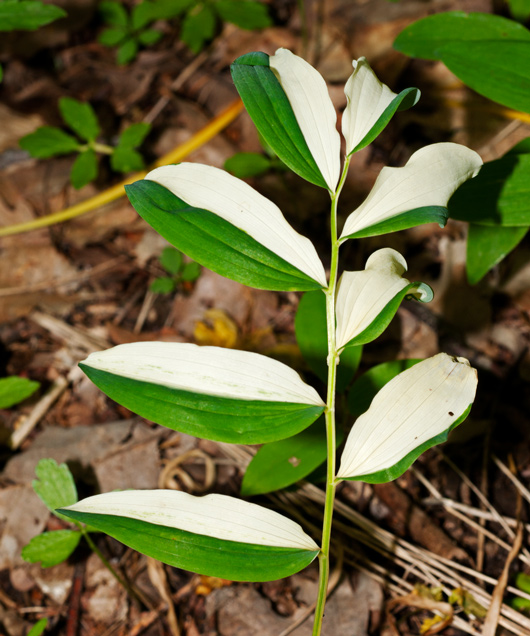
Colour influences pollinator behaviour
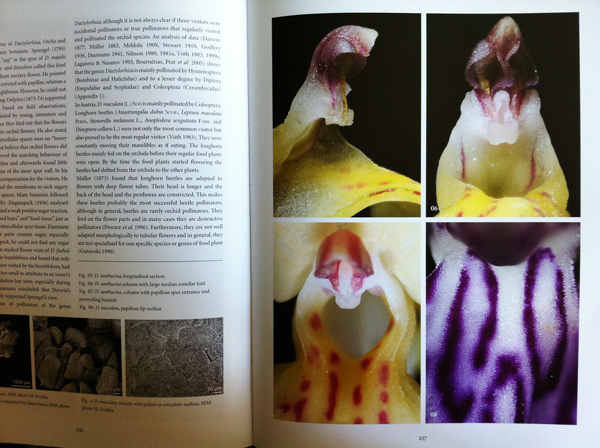
Form and function of the flower organs are the main focus of the new fascinating book The Flower of the European Orchid by Jean Claessens and Jacques Kleynen. Illustrated by great macro as well as microscopic photos this important opus presents a comprehensive description of the structure of orchid flowers with the different European genera. In a foreword, Richard Bateman writes: „No other family of plants can match the orchids for their sheer charisma“. But the excitement goes along with a certain scientific pain – Bateman stresses that there still remain major scientific uncertainties which „further torment us“ – among them questions of evolutionary adaptation.
The orchids’ strategies of fertilization are manifold and the book explains how the specific construction of the column (gynostemium) supports allogamy by pollinators or autogamy (self-fertilization). Especially intriguing are the strategies of Dactylorhiza, Orchis and other genera without any nectar in the spur. Claessens and Kleynen explain that the pollinators of Orchis mascula are „recently emerged, naïve bees or exploratory insects that have not yet learned that the flowers offer no reward” (p. 220). The authors also cite the study of L. Dormont, R. Delle-Vedove, J.-M. Bessière, M. Hossaert-Mc Key und B. Schatz about the presence of white-flowered Orchis mascula which underlines „the importance of visual cues for attracting pollinators“ (p. 220).
In the Dactylorhiza chapter the authors write: „Colour can also influence pollinator behaviour“ (p. 240). With regard to the red and the yellow forms of Dactylorhiza sambucina they refer to experiments showing that experienced bumblebees „preferred by far the morph that most resembled the rewarding plant on which they have fed previously“. Vice versa it may be presumed that there may be a form of evolutionary adaptation directed to develop visual cues which are different from non rewarding plants being abundant in a certain region – as it could be the case in Western Ireland with the many white-flowered forms of Dactylorhiza fuchsii on meadows with earlier flowering Orchis mascula.
Ophrys speculum f. flavescens
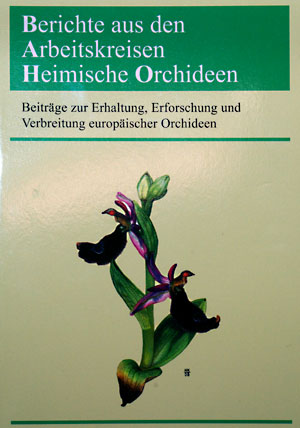 In the latest issue of “Berichte aus den Arbeitskreisen Heimische Orchideen” (27/2, 2010), Klaus Boie presents a rare hypochrome form of Ophrys speculum in his article about orchid-findings in western Andalusia (p.117-122). He found this forma flavescens in the Spain region of Andalusia, in the midst of a large group of Ophrys speculum, as he writes.
In the latest issue of “Berichte aus den Arbeitskreisen Heimische Orchideen” (27/2, 2010), Klaus Boie presents a rare hypochrome form of Ophrys speculum in his article about orchid-findings in western Andalusia (p.117-122). He found this forma flavescens in the Spain region of Andalusia, in the midst of a large group of Ophrys speculum, as he writes.
The marking of the labellum is just white, the other parts of the flower are yellowish-green. As with other hypochrome forms of Ophrys, the photo shows a total lack of anthocyanins. But the flower has still chlorophyll embedded – in contrast to albiflora forms of other orchid genera with their their pure white flowers. Probably the Ophrys species need the flower’s contribution to photosynthesis, because the leaves of the rosette are withering at an early stage.
Albiflora plants influence naïve pollinators
White-flowered orchid varieties are not just a “freak of nature” – they have quite obviously some biological function. A group of scientists in Montpellier in Southern France has found that the existence of albiflora plants in a population of Orchis mascula is connected with a much higher fruit set of the purple-flowered plants than in populations where there are no white-flowered Orchis mascula:
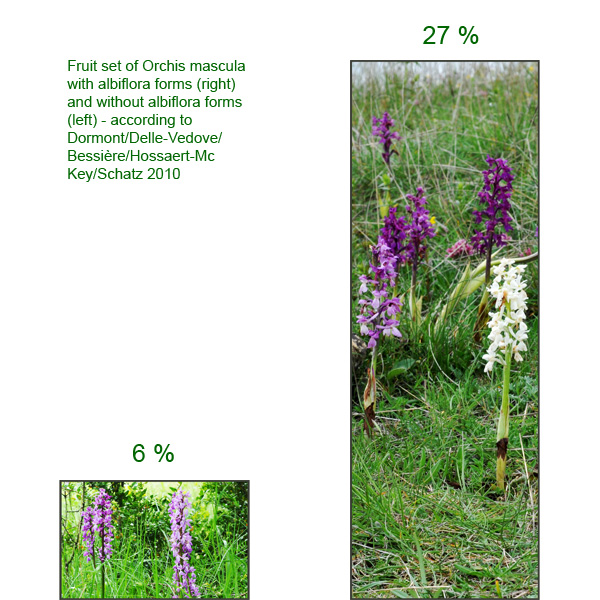
“Surprisingly, our study showed that the presence of co-occurring white-flowered individuals led to significantly higher reproductive success of nearby purple-flowered individuals (mean fruit set 27%), while white-flowered plants themselves had the same low fruit set (6%)”, the authors of the study – L. Dormont, R. Delle-Vedove, J.-M. Bessière, M. Hossaert-Mc Key and B. Schatz – wrote in their article in New Phytologist (2010) 185: 300–310. The flowers studied – overall 11 709 at 805 plants – showed almost the same increased fruit set when the researchers planted some ping-pong balls which mimic the white Orchis mascula inflorescences: “The effect was virtually identical in magnitude (fruit set increased from 6 to 27%), whether the nearby white-coloured object was an O. mascula inflorescence or a ping-pong ball.” The nearer a purple-flowered plant to the white colour, the higher was the fruit set developed due to a successful pollination.
The authors explain their surprising results with pollinator behaviour after visiting Orchis mascula who belongs to the food-deceptive orchids: “It seems plausible to suppose that after unrewarding visits to purple flowers, naïve pollinators probably avoid homogeneous populations of purple flowers, and may then preferentially orient to a different colour or to a colour contrast such as a mix of white and purple flowers.” Pollinators of Orchis mascula are bumblebees (Bombus, Psithyrus), solitary bees (Eucera, Nomada, Andrena, Apis) and the beetle Cetonia aurata.
The albiflora varieties are quite rare in the populations studied in Southern France: The authors counted 0.9 to 1.4 percent in different populations. But this is much higher than the percentage which could be assumed in the case of spontaneous mutations affecting floral pigmentation genes with an average of just 0.1 percent. Regarding the higher percentage of albiflora varieties with Orchis mascula the authors state that “it is unlikely that such high frequencies could be the result of repeated spontaneous mutations alone” – and this should also apply to the case of other orchid species with a higher percentage of white-flowered plants like Anacamptis morio or Dactylorhiza fuchsii in Western Ireland.
The white-flowered Orchis mascula themselves have only a low fruit set, but they “help” the purple-flowered plants of their species to be pollinated. “In O. mascula, the presence of whiteflowered variants might be regarded as an adaptation that benefits the purple-flowered relatives of white-flowered morphs, rather than providing a direct benefit to whiteflowered individuals”, the authors wrote and assumed that there is some “mechanism of kin selection” responsible to grant a higher percentage of albiflora plants.
The scientists in Montpellier are pursuing their research with other species as well. Laurent Dormont wrote me that they have also studied white-flowered plants of Calanthe sylvatica on the Caribbean island of La Réunion (the results to be published in Plant Systematics and Evolution and also the floral volatiles of white-flowered orchis species.
Cephalanthera rubra f. albiflora revisited
 This year I had the chance to visit the white flowering form of Cephalanthera rubra in the Hesse part of the Rhoen some days earlier than last year. But first I followed a hint and looked up a place further in the South, near Ahlersbach. Quite near a path through the forest a white Cephalanthera rubra with a slight hue of pink! The pink colour is well visible in the buds, where the remaining pigments are more concentrated than in the opened flower.
This year I had the chance to visit the white flowering form of Cephalanthera rubra in the Hesse part of the Rhoen some days earlier than last year. But first I followed a hint and looked up a place further in the South, near Ahlersbach. Quite near a path through the forest a white Cephalanthera rubra with a slight hue of pink! The pink colour is well visible in the buds, where the remaining pigments are more concentrated than in the opened flower.
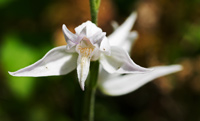 At the second place near Huenfeld, characterized by an old beech mentioned by Marco Klueber in his great book about “Orchids in the Rhoen” the albiflora plants of Cephalanthera rubra are splendidly flowering. The Swedish botanist L. Anders Nilsson showed (in an article in Nature, 1984) that Cephalanthera rubra mimics the floral coloration of Campanula in the visual system of bees in order to be pollinated by them, especially by male bees of the genus Chelostoma. Since Cephalanthera rubra is flowering before Campanula, they are quite attractive for the bees. It would be interesting to see how bees are reacting to the albiflora forms of Cephalanthera rubra.
At the second place near Huenfeld, characterized by an old beech mentioned by Marco Klueber in his great book about “Orchids in the Rhoen” the albiflora plants of Cephalanthera rubra are splendidly flowering. The Swedish botanist L. Anders Nilsson showed (in an article in Nature, 1984) that Cephalanthera rubra mimics the floral coloration of Campanula in the visual system of bees in order to be pollinated by them, especially by male bees of the genus Chelostoma. Since Cephalanthera rubra is flowering before Campanula, they are quite attractive for the bees. It would be interesting to see how bees are reacting to the albiflora forms of Cephalanthera rubra.
With regard to pollinators my visit on June 24th had a special highlight when I saw a wasp (Argogorytes mystaceus) pollinating Ophrys insectifera. The insect pseudocopulated two flowers in a timeframe of more than seven minutes.
Even more fuchsii diversity
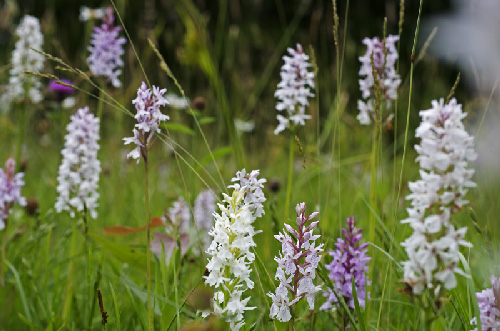
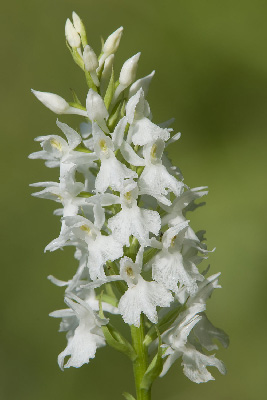 Similar to The Burren there are also some continental locations where Dactylorhiza fuchsii tends to develop white or at least bright flowers. In the Belgian province of Liège, near Lanaye, there are dozens of albiflora forms of this species, as Jeroen Gerdes told me – he sent me the photo at the left.
Similar to The Burren there are also some continental locations where Dactylorhiza fuchsii tends to develop white or at least bright flowers. In the Belgian province of Liège, near Lanaye, there are dozens of albiflora forms of this species, as Jeroen Gerdes told me – he sent me the photo at the left.
Today I visited a meadow near Biebergemuend in the Hesse part of the mountain range called Spessart. On a space of about 5,000 square meters I counted about 300 Dactylorhiza fuchsii with the following distribution of flower colours (in per cent):
| Dactylorhiza fuchsii with | % |
|---|---|
| dark pink flowers | 2 |
| medium pink flowers | 6 |
| bright pink flowers | 45 |
| white flowers and labellum marking | 44 |
| white flowers without marking | 3 |
| total | 100 |
In total 10 of about 300 Dactylorhiza fuchsii are albiflora forms – such a frequency is quite higher than usually observed with this or other orchids species and leads to the assumption that there might be some gradual or saltational evolution under way.
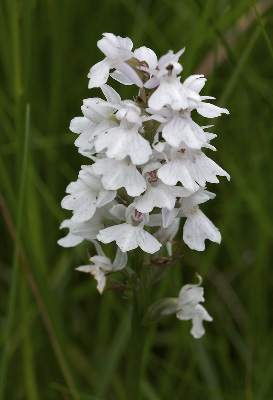 Among the other plants in this area I noted Dactylorhiza majalis (withered), Dactylorhiza fuchsii x majalis, Platanthera bifolia, Neottia ovata, Rhinanthus minor, Cirsium arvense, Campanula persicifolia, Picris hieracioides and Arnica montana. Dactylorhiza majalis grows in the neighbourhood of wet ditches along the meadow – and there are also hybrids of D. majalis and D. fuchsii – still flowering while D. majalis is already withered. The hybrids are rather strong, some of them with a height of up to 50 cm. They can easily be determined by their broad leaves and the rounded labellum of the flowers with a reduced medium lobe. There is also an albiflora form of Dactylorhiza fuchsii x majalis (right).
Among the other plants in this area I noted Dactylorhiza majalis (withered), Dactylorhiza fuchsii x majalis, Platanthera bifolia, Neottia ovata, Rhinanthus minor, Cirsium arvense, Campanula persicifolia, Picris hieracioides and Arnica montana. Dactylorhiza majalis grows in the neighbourhood of wet ditches along the meadow – and there are also hybrids of D. majalis and D. fuchsii – still flowering while D. majalis is already withered. The hybrids are rather strong, some of them with a height of up to 50 cm. They can easily be determined by their broad leaves and the rounded labellum of the flowers with a reduced medium lobe. There is also an albiflora form of Dactylorhiza fuchsii x majalis (right).
Albiflora studies in Ireland
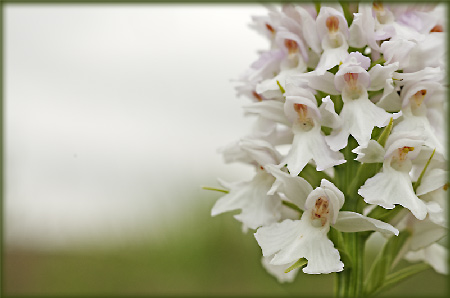
The evolution of certain orchid species is far from being finished. The Burren, a region in County Clare at the Western coast of Ireland, illustrates this fact by its manifold colour varieties of Dactylorhiza fuchsii. In 1988, R.M. Bateman and I. Denholm, came to the result that the Burren populations of Dactylorhiza fuchsii show more often a lack of the purple pigment anthocyanin than plants in other regions of the British Isles:
| Percentage of Dactylorhiza fuchsii lacking | Burren | other regions |
|---|---|---|
| leaf markings | 43 | 13 |
| labellum markings | 48 | 15 |
| labellum anthocyanins | 48 | 12 |
| all floral anthocyanins | 35 | 8 |
| all anthocyanins in flowers, stem, leaves and bracts | 25 | 6 |
(Source: R.M. Bateman/I. Denholm: A reappraisal of the British and Irish dactylorchids, 3. The spotted-orchids. In: Watsonia 17 (1988), p.332)
When exploring the fascinating area around the Lough Gealain and the Mullaghmore mountain these results seem to be quite realistic. In other areas as well there are many plants, which have bright or white flowers but still retain anthocyanins visible in the markings of the labellum. In a limited area of 40 square meters in the region of Rockforest, northeast of Corrofin, I counted 50 flowering Dactylorhiza fuchsii (in addition to 7 with buds) with the following characteristics:
| Dactylorhiza fuchsii with | |
|---|---|
| dark pink flowers | 0 |
| medium pink flowers | 11 |
| bright pink flowers | 17 |
| white flowers and line markings | 3 |
| white flowers and dot markings | 17 |
| white flowers without markings | 2 |
| total | 50 |
Among the other plants in this area in the middle of a vast limestone pavement there are Orchis mascula, Geranium sanguineum, Rosa pimpinellifolia, Calluna vulgaris, Lotus corniculatus and Pteridium aquilinum.
The following image illustrates the broad variety not only of colours but also of the labellum forms of Dactylorhiza fuchsii in The Burren (some of the examples obviously showing a certain introgression with Dactylorhiza maculata). It becomes clear that most plants have less floral anthocyanins than continental populations of the species – for example the large forest populations in the French region Causses with its deep pink flowers. The pigments are first reduced in the sepals. This reduction continues in the base colour of the labellum. Then the markings of the labellum are reduced, often only a small rest is retained at the mouth of the spur. Even the very white flowers still have coloured pollinia but their colour is less intense. There is also a wide variety of labellum forms. Especially the central lobes largely differ. And there is the extreme case of a white flowering plant whose lateral lobes are reduced to a minimum (lowest row in the middle).
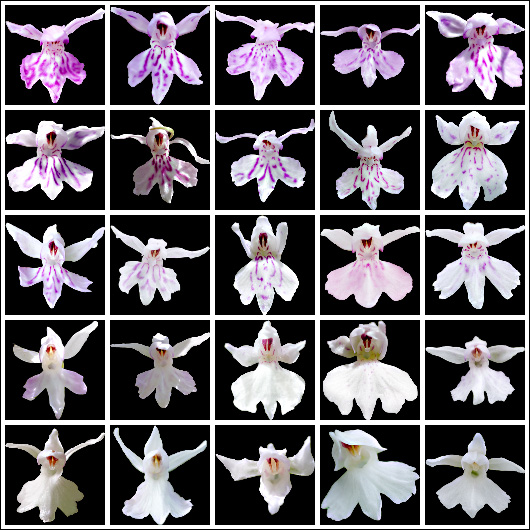
Most Irish and British botanists stress that the Dactylorhiza fuchsii var. okellyi (some authors view this as subspecies or even as species) must not be mixed up with the albiflora forms of fuchsii. Anne and Simon Harrap (Orchids of Britain and Ireland, 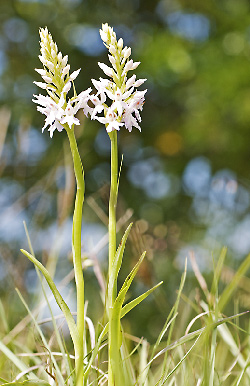 2005) are writing: “A lot of controversy surrounds okellyi” and explain: “In The Burren and elsewhere these classic white-flowered okellyi are just part of a population of plants with a variable flower colour”. Brendan Sayers and Susan Sex (Ireland’s Wild Orchids, 2008) stress that Dactylorhiza fuchsii var. okellyi flowers late, beginning in July. The photo in their field guide shows a flower with a labellum, which is deeply divided into three lobes. Charles Nelson (Wild Plants of The Burren and the Aran Islands, 2008) indicates that Dactylorhiza fuchsii f. okellyi flowers from June to August and has pure white flowers “without any pink tints or marks” and a “lip flat with 3 almost equal, deeply-cut lobes”. According to Pierre Delforge (Guide des orchidées d’Europe, 2005), who mentions a flowering period from May to July, the labellum has a maximum width of 8 mm (in contrast to fuchsii with 8-16 mm). Pat O’Reilly and Sue Parker (Wild Orchids in The Burren, 2007) have noted that “groups of pure-white orchids … are more likely to be O’Kelly’s Spotted-orchids than single plants, which might be just very pale examples of the Common Spotted-orchid”. When exploring the limestone pavements between Poulsallagh and Rockforest you’ll find lots of white-flowered Dactylorhiza fuchsii, rather small and with a pyramidal spike in the beginning of flowering, which are very similar to pink-flowered plants of the species – they should be considered as albiflora forms. Two times I found a pair of taller plants, very slender and with a distinct appearance of spike or flowers, which could be addressed as Dactylorhiza fuchsii var. okellyii.
2005) are writing: “A lot of controversy surrounds okellyi” and explain: “In The Burren and elsewhere these classic white-flowered okellyi are just part of a population of plants with a variable flower colour”. Brendan Sayers and Susan Sex (Ireland’s Wild Orchids, 2008) stress that Dactylorhiza fuchsii var. okellyi flowers late, beginning in July. The photo in their field guide shows a flower with a labellum, which is deeply divided into three lobes. Charles Nelson (Wild Plants of The Burren and the Aran Islands, 2008) indicates that Dactylorhiza fuchsii f. okellyi flowers from June to August and has pure white flowers “without any pink tints or marks” and a “lip flat with 3 almost equal, deeply-cut lobes”. According to Pierre Delforge (Guide des orchidées d’Europe, 2005), who mentions a flowering period from May to July, the labellum has a maximum width of 8 mm (in contrast to fuchsii with 8-16 mm). Pat O’Reilly and Sue Parker (Wild Orchids in The Burren, 2007) have noted that “groups of pure-white orchids … are more likely to be O’Kelly’s Spotted-orchids than single plants, which might be just very pale examples of the Common Spotted-orchid”. When exploring the limestone pavements between Poulsallagh and Rockforest you’ll find lots of white-flowered Dactylorhiza fuchsii, rather small and with a pyramidal spike in the beginning of flowering, which are very similar to pink-flowered plants of the species – they should be considered as albiflora forms. Two times I found a pair of taller plants, very slender and with a distinct appearance of spike or flowers, which could be addressed as Dactylorhiza fuchsii var. okellyii.
Dactylorhiza maculata also tends to develop very pale flowers in The Burren. But most of them retain at least a faint marking on the labellum. The variety of Dactylorhiza maculata (the plants in Ireland are in general addressed as Dactylorhiza maculata ssp. ericetorum) seems to be not so wide as the variety of Dactylorhiza fuchsii. The relative frequency of Orchis mascula f. albiflora is in the same range as in continental Europe. Among thousands of plants – Orchis mascula being the most frequent orchid of the region – I’ve seen just two white ones. And there wasn’t one single albiflora form of Dactylorhiza incarnata or Dactylorhiza majalis ssp. occidentalis (on the Aran Island of Inisheer).
Compared with the relative stability of the other plants, the broad variability of Dactylorhiza fuchsii in The Burren clearly shows that this species is still in a state of an ongoing evolutionary process. It can only be speculated why Dactylorhiza fuchsii in The Burren prefers brighter or even white flowering – in the midst of an abundance of pink and purple flower colours on the meadows of the region.
Partial albiflora form with Dactylorhiza majalis
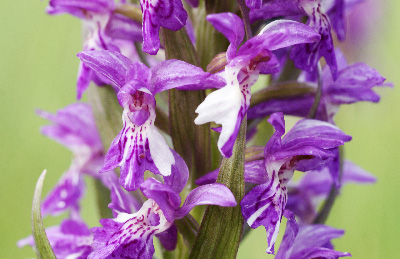
Studying a marsh with about 2,000 Broad-Leaved Marsh Orchids (Dactylorhiza majalis) at the Southern edge of the Rhoen region in Germany I saw a group of three albiflora plants together with Menyanthes trifoliata, Caltha palustris and other marsh plants. Even more interesting was another albiflora plant in a distance of about 40 meters with an orchid in its direct neighbourhood showing a kind of partial albiflora: Most of its flowers have the standard purple colour but some flowers are partly purple, partly white – either in the lip or in the petals.
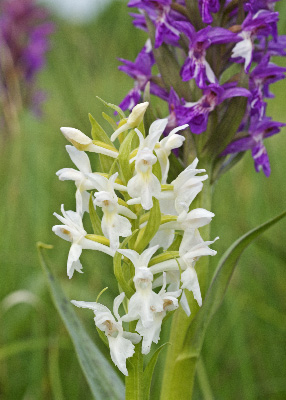 Obviously, the genetic allele containing information for the albiflora form has plaid a certain role for this plant – but it was dominated by the DNA, which contains the information for the standard colour. This observation as well as a similar one in Southern France with Anacamptis morio poses questions about the recessive character of the albiflora allele. There might be some cases where the albiflora allele of one parent plant is not totally restrained by the dominant purple allele of the other parent plant which results in such purple and white spotted flowers. Before I continued the trip to a charming meadow with hundreds of Anacamptis morio (among them two albiflora) and Orchis mascula I made use of the rising morning sun to make some more photos of the Dactylorhiza majalis f. albiflora trio:
Obviously, the genetic allele containing information for the albiflora form has plaid a certain role for this plant – but it was dominated by the DNA, which contains the information for the standard colour. This observation as well as a similar one in Southern France with Anacamptis morio poses questions about the recessive character of the albiflora allele. There might be some cases where the albiflora allele of one parent plant is not totally restrained by the dominant purple allele of the other parent plant which results in such purple and white spotted flowers. Before I continued the trip to a charming meadow with hundreds of Anacamptis morio (among them two albiflora) and Orchis mascula I made use of the rising morning sun to make some more photos of the Dactylorhiza majalis f. albiflora trio: 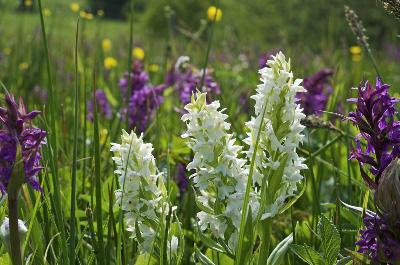
Albiflora orchids in Nepal
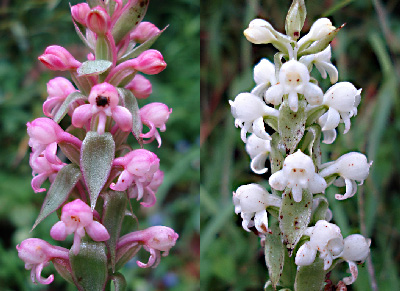
I got these photos of Satyrium nepalensis from the botanist Bhakta Bahadur Raskoti in Katmandu who has just published a new book presenting “The Orchids of Nepal”. He wrote me that there are some species of orchids in Nepal which are flowering in pink and rarely in white. In addition to Satyrium nepalensis those are Spiranthes sinensis, Rhynchostylis retusa or Anthogoneum gracile. Spiranthes sinensis reminds of the European Spiranthes spiralis, its standard form shown in the book of Bhakta Bahadur Raskoti has dark pink sepals and petals and a white labellum. “Orchids of Nepal” presents 302 species with more than 900 photos. Among them 14 species are new reports for the orchid flora of Nepal.
